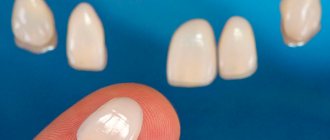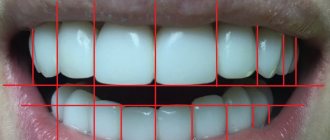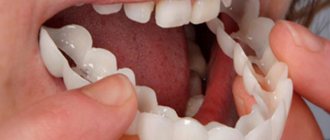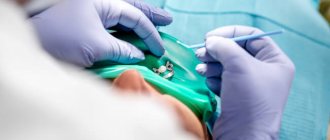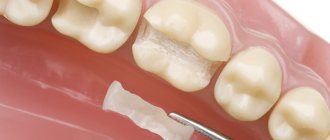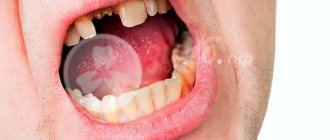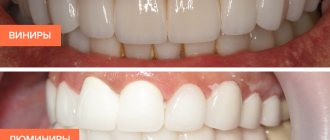In modern dentistry, the importance of the dentist is increasing and the dental technician is becoming less and less important. It is the doctor who designs the final result, taking into account the requirements for the aesthetics and functionality of the patient’s maxillofacial system.
Traditionally, aesthetic analysis involves photographing the patient. Photographs are used to evaluate the outcome of treatment, but it is not practical to use them for planning, since a two-dimensional image does not give accurate results. Instead, they resort to 3D visualization, when the face, teeth, and gums are displayed in a three-dimensional projection.
Computer modeling in dental prosthetics - what is it?
Computer modeling, as is already clear from the very name of this technology, allows you to use a regular computer/tablet for dental prosthetics, but, of course, with special “software” (that is, software). Using it, a three-dimensional digital model of the patient’s future smile is created, taking into account all the anatomical features - the shape and color of the teeth, their size and combination with the contours of the face, skin color, gum level, size of the lips and nose, and the width of the smile.
The use of a computer for smile modeling not only speeds up the process of prosthetics, but also optimizes the relationship between the dentist and the patient, as well as the dentist and the dental technician. Patients especially like that they actively participate in the modeling process - together with the doctor they choose the color and shape of their future teeth.
Complex on 4 OSSTEM implants with delayed loading - from RUB 170,000.
Complex implantation Osstem (South Korea) with delayed loading after 4-6 months.
Guarantee for the doctor’s work - unlimited Call now or order a call
Opening hours: 24 hours a day - seven days a week
For computer smile modeling in dentistry, a concept called Digital Smile Design, or DSD for short, is used - which translates to “digital smile design.” It was developed in 2007 by Brazilian dental technician Christian Coachman, and since then it has gained great popularity among the global dental community. By the way, DSD models the future smile, which becomes a kind of aesthetic standard for the prosthesis, but does not model the prosthesis itself - for this they use other solutions, which we will discuss below.
Neuromuscular diagnostics in orthopedics
It is impossible not to mention such an important aspect of preparation for prosthetics as studying the work of the maxillofacial muscles in dynamics. The data obtained as a result of such diagnostics allows not only to make the orthopedic apparatus as comfortable as possible in use, but also with its help to correct existing defects in the functioning of the dental system. As part of such an examination, specialists conduct computer diagnostics of muscle tone, scan and record changes in muscle tissue at the time of jaw movement, and evaluate noise in the joint area.
Tasks of computer smile modeling
- select the shape and color of crowns/veneers in accordance with the patient’s requests,
- see your future smile with new teeth in advance and “try on” it: this happens on a computer screen or on a tablet,
- assess the performance of the prosthesis in advance: how the jaws will close, whether the bite relationship will be disrupted,
- rejuvenate the face through Dental face lifting and the application of the principles of the “golden” section and “beauty mask”: these parameters are taken into account during digital modeling (colors and shapes of crowns) - as a result, the face looks more attractive and younger,
- form and study a model of the patient’s jaw before implantation.
What is 3D modeling and planning in dentistry
Digital technologies are integrated into many processes during dental restoration; often the implantation itself using them is called 3D implantation (from the English three-dimensional). It is not a separate method or protocol; rather, it is a qualitatively different approach to the process of dental restoration.
3D technologies include those that help volumetrically visualize information about the condition of the jaw or create three-dimensional models, both virtual and real, at the stage of developing the implantation process:
- computed tomography (CT): using X-ray scanning, creates accurate digital copies of the maxillofacial apparatus,
- programs for visualization and 3D modeling: for virtual study of the stages of implantation and prosthetics,
- 3D printing: printers that create highly complex real-life models of jaws and surgical templates (as well as prosthetics and mouth guards) from specialized materials. Templates are required at the stage of surgery to install implants or to work out the process - in fact, to hone manual skills.
%akc54%
The basis of the system is a computer program that processes incoming information from a computed tomograph and is connected to a 3D printer, oral scanners, and robotic machines. The software allows you to create a very accurate treatment plan, assess the quality and size of bone tissue, select the location of the implant, and much more (more on this below).
There are many different programs that dentists use. Among them are universal and specialized: NobelClinician, SimPlant, Blue Sky Plan, coDiagnostiX.
Indications and contraindications for digital modeling
The scope of computer smile design in dentistry is quite wide. Digital smile design is suitable for patients who need prosthetics with restorative inlays, veneers (as well as their variations - ultraneers, nanoeers, etc.), crowns, bridges, and, less commonly, removable dentures.
The DSD concept is used in the development of implant prostheses. Moreover, these can also be either single crowns on implants or extended bridge-like structures with acrylic gum (its color and shape are also digitally modeled).
Don't know what type of prosthetics to choose?
We will help in the selection, advise where to read more information and compare types of prosthetics.
Consultation with an orthopedic doctor in Moscow clinics is free! Call now or request a call
Working hours: from 9:00 to 21:00 - seven days a week
The only contraindications to computer modeling are contraindications to the installation of dentures. This includes caries, the presence of serious inflammation in the oral cavity and massive deposits of tartar. For example, untreated swelling of the gums or installing a filling after the “smile parameters” have been removed will lead to the orthopedic design being uncomfortable. Therefore, before creating a prosthesis, even a virtual one, existing dental diseases should be cured.
Is it possible to do without 3D technology during implantation?
No, the success of implantation directly depends on proper planning of the operation. Neither an orthopantomogram nor an x-ray can serve as a basis for implantation. Only CT, in combination with data processing with a special computer program, can provide enough information to select an implantation protocol and create a step-by-step implantation scheme.
Thanks to its presence, risks are reduced, surgical intervention time is shortened, the highest precision of implant installation and a pre-planned result are achieved. Based on the results of the 3D modeling, the doctor can be confident that the implant will achieve good primary stabilization.
For which restoration method is DSD suitable?
Dental prosthetics is carried out using two methods – direct and indirect. But digital smile design is used only in one case, read about it further.
Direct method - the prosthesis is created in the patient’s mouth
The direct method most often involves applying a liquid filling directly to the patient's teeth while the patient is in the dental chair. This is how they restore small chips, cracks, and darkening on the front teeth, and restore chipped enamel of the lateral teeth. Before the filling hardens, the dentist can give the patient a mirror to evaluate the result and tell him whether he is satisfied or not. There is no need for computer modeling here because all the work is done by hand (not in a laboratory).
Indirect method - the prosthesis is created in the laboratory
Dentures created in a dental laboratory are of much higher quality than those produced by the direct method. For the indirect manufacturing method, in addition to the skills of specialists, equipment is required - various forms for real models, firing and baking ovens, milling machines, presses and modern high-quality materials (ceramics, glass ceramics, zirconium dioxide).
Here, the use of 3D modeling of a future smile helps the dental technician better navigate the work being performed, because DSD data is combined with special programs that model the prosthesis itself and control its production. Of course, not all clinics use the original Digital Smile Design program (because they don’t want to purchase it from the developers), and digital modeling, in principle, works the old fashioned way manually. But as practice shows, it is this concept that helps create the most beautiful, comfortable and durable designs.
Advantages of dental restoration using CEREC 3D technology:
- All restorations are highly accurate and perfectly match the treated tooth. At the same time, the distance between the treated tooth wall and the crown/onlay is about 20–60 microns, with such accuracy the possibility of the crown/onlay becoming uncemented, saliva getting under it and infection is practically excluded;
- the ceramics used for restorations do not cause allergies, are varied in shades, transparency and even density of the material, so the restored teeth are indistinguishable from natural healthy ones;
- restoration of teeth in one visit to the dentist. Thanks to the 3D camera, there is no need to take impressions and install temporary fillings or crowns.
Dental restoration using 3D technology is reliable, aesthetic and functional.
Make an appointment with doctors
: Goncharova T.A., Selivanova I.V., Cherevko N.I.
You can find out more detailed information and schedule a consultation through the online form.
Make an appointment
(812) 232-88-25, 233-19-08
Stages of computer modeling and prosthetics
The process of dental restoration includes several stages that follow one after another. Let's look at them further and tell you when computer smile modeling is used and what initial data is needed for it.
Taking impressions or 3D scanning of the oral cavity
Now computerization can accompany the prosthetics process from start to finish. For example, dentists often abandon the usual casts or impressions of the dentition and use digital “casts” (using a 3D oral scanner).
But the usual physical impressions can also be used. True, in this case you will have to transfer them to the laboratory, make a plaster model1 and scan it - in order to create a digital version for its correction in Digital Smile Design. This route takes longer (2-7 days).
Photo and video session, assessment of bite parameters
Photographs (as well as short videos) are taken in order to evaluate the patient’s smile parameters, their relationship with other facial parameters, and also to understand how the facial muscles work. Filming is carried out when the patient is smiling, calm or deliberately “angry”, when he speaks or is silent. All photos and videos, and there can be several dozen of them, are loaded into the program and combined with digital impressions.
Also at this stage, the dentist uses various jaw movement analyzers (articulators, HIP plane analyzer, face bows). After all, in a future prosthesis, not only beauty is important, but also how it will relate to the existing bite.
Virtual smile modeling
All received data (imprints, photos, etc.) are entered into a computer smile modeling program. Then the parameters are processed, combined, and a three-dimensional projection is displayed on the screen that fully corresponds to the patient’s natural dentition. Next, adjustments are made to improve your smile. Moreover, you can immediately make several options for a new smile - with different shapes or heights, widths of teeth, with different shades of enamel, for example. And then the best option is selected, both from the dentist’s point of view and based on the patient’s wishes.
By the way, such a virtual projection can be combined with digital computed tomography of the patient and begin to develop a prosthesis, incl. and for placement on implants. Popular programs for creating prostheses are CAD/CAM systems CEREC and inLab from Dentsply Sirona, NobelProcera from Nobel Biocare.
Wax modeling and fitting of the prosthesis blank
In some cases, patients who need veneers, extended bridges or removable orthopedic structures should go through one more stage - fitting of the prosthesis blank. This is necessary to assess the comfort of the new teeth and their relationship with the neighboring ones. Here, after developing a model, the dental technician makes a “trial” prosthesis (from silicone, plastic, etc.), and then attaches it to a wax model, after which he hands it over to the orthopedic dentist, who tries it on the patient. If necessary, adjustments are made and the layout is sent back to the laboratory.
Creation of the prosthesis and its final installation
The approved version of the prosthesis goes through all stages of manufacturing - milling on a robotic machine, baking, glazing, polishing, etc. The production technology depends on the type of prosthesis, the properties of the material and its volume, which is needed to create each specific structure.
Previously, all production machines were manually adjusted by a person, using measurements also taken by hand. Therefore, there was no need to talk about accuracy, especially the first time. Today, dental devices (namely CAD/CAM systems) are configured largely automatically, in accordance with the parameters set by the computer. Therefore, inaccuracies and human errors are excluded here.
Today, dental crowns, bridges and the thinnest veneers are cut automatically by machines - quickly and the first time. As a result, the doctor simply fixes the prosthetic structure, without first trying it on and subsequent adjustment.
How is 3D dental implantation performed?
Three-dimensional implantation is not a separate prosthetic method. It complements any protocol, but the use of 3D visualization is especially important when using one-stage implantation methods with immediate loading, when it comes to restoring lost teeth against the background of jawbone atrophy and without undergoing a bone augmentation procedure.
The approach involves several stages.
Stage 1: photometry
This is a series of ordinary photographs of the patient's face, with and without a smile, from the front and from the side, with the mouth open, closed or slightly open. All of them are necessary to determine how the absence of teeth affected the state of the bite, facial symmetry, as well as to evaluate the final result after installing a denture.
A big plus for the patient himself is that he will be able to evaluate from the outside what transformations have occurred after dental implantation. After all, not only the smile changes, but also the wrinkles around the mouth are smoothed out, the lower part of the face is enlarged, and the position of the jaws is normalized.
Stage 2: computed tomography (CT)
A tomograph is a scanner that allows you to obtain three-dimensional images of the patient’s jaws. They can examine the volume and quality of the jaw bone, the location of all teeth and their roots, determine the presence or absence of foci of inflammation in the periodontal tissues, the position of the jaw nerves and the bottom of the maxillary sinuses of the upper jaw. The obtained data is entered into a computer program.
It is best if CT is performed not in conventional dentistry, but in specialized centers where more expensive and accurate equipment is installed. For dental implantation, image resolution and detail is very important, especially when loading this data into a computer program. One of the modern options is multislice computed tomography, which allows you to recreate the patient’s entire jaw system in even more detail and simulate delayed treatment results.
Stage 3: 3D visualization
A special program creates an accurate model of the patient’s jaw system. Here, a virtual operation is performed to remove diseased teeth, and places for implants are selected with the most dense bone of sufficient volume. Computer modeling allows you to select implant models of a certain size and design in exact accordance with the structure of the patient’s jaw system. At the final stage, the design of the future prosthesis must be worked out.
In difficult cases, a consultation of doctors is held at the Smile-at-Once clinic. This allows us to choose the most optimal solution to the problem and avoid mistakes in treatment.
Stage 4: printing templates
After three-dimensional visualization of the entire treatment process, preparations are made for the installation of implants and subsequent prosthetics:
- making a base for a future prosthesis, taking into account the plan worked out on a computer,
- 3D printing of surgical templates. These are original mouth guards, aligners, caps or stencils made of transparent silicone with guide holes.
Stage 5: installation of implants
Implant placement is carried out according to the plan and using surgical templates for dental implantation. Largely thanks to them, implants are installed in a minimally invasive way - without massive incisions, but through a puncture of the gums. They are literally screwed into the jawbone, even if we are talking about two-piece structures. In addition, templates can almost completely eliminate the risk of medical errors, especially if the implant surgeon has to work in extremely limited space in the presence of bone tissue atrophy and the slightest deviation of the implant can lead to damage to the facial or jaw nerves or maxillary sinuses.
Dental implantation in 3D places increased demands on the professionalism of the implantologist. He must be not just an implantologist or surgeon, but an oral and maxillofacial surgeon with a thorough knowledge of the anatomy of the entire jaw system. He must also be a professional computer user - the ability to type texts or read news on the Internet will not be enough to work out complex implantological treatment.
Stage 6: taking impressions
After installing the implants, impressions must be taken, and a HIP analyzer is used to assess the degree of occlusion (closing of the jaws). Despite the fact that the prosthesis base is created immediately after three-dimensional visualization of the treatment process, impressions are still required - they are needed for the final modeling of the prosthesis base, as well as elaboration of the design taking into account the patient’s bite.
Based on the casts, a plaster model of the patient’s jaw system is created, which is fixed in a special articulator device. In this way, the work of the temporomandibular joint is also taken into account.
Careful elaboration of the prosthesis is especially important if the patient is restoring only part of the dentition or only one jaw - the prosthesis should be as comfortable as possible in relation to the antagonist teeth (located on the opposite side).
Stage 7: prosthetics
This is the final and most pleasant stage for any patient, because his teeth return. Here, computer modeling is used mainly to develop a metal frame - the base of a denture. Such a base is necessary to connect the installed implants and stabilize their position.
After computer planning of dental implantation (stage No. 3), a metal prosthesis base is created on a special machine. But after installing the implants, the dental technician adjusts it and adapts it to the bite, as well as lining it with acrylic (this is an artificial gum) and installing metal-plastic crowns. This approach is used for almost all immediate load protocols. This prosthesis is temporary or adaptive. The period of wearing it depends directly on the implantation technique: minimum – 3-6 months, maximum – up to 5 years.
Some methods require re-prosthetics immediately after the implants have been implanted, that is, after 3-6 months of wearing the first prosthesis. We are talking about original protocols from the companies Nobel and Straumann, which involve the installation of 3-4 implants on the jaw and immediate loading with a prosthesis (all-on-4 or Straumann Pro Arch).
The beam or frame for a permanent prosthesis is created individually directly in the company’s laboratory - Nobel or Straumann, respectively. To do this, impressions taken after implantation are sent to the Russian representative office of the companies - they are scanned there and sent to the head office, i.e. directly to the laboratory (USA-Nobel or Switzerland-Straumann). Within a few days, an individual frame of the future prosthesis is developed for a specific patient using software and a special Cerec milling unit. Then he returns to the clinic. Already in the Smile-at-Once dental laboratory, dental technicians line it with acrylic and plastic (for example, Condulor, which is highly durable), and install plastic, ceramic-composite or even ceramic crowns.
Cerec is very expensive equipment, so it is extremely rare in dental laboratories in Moscow. Dentures developed using this technology are characterized by incredible positioning accuracy in the patient’s mouth, fit perfectly under the bite and last for several decades. They have a 5-year warranty, but their service life is practically unlimited, which means re-prosthetics are not required.
Expert opinion
Nikolay Vladimirovich Namdakov Maxillofacial surgeon, implantologist, orthopedist Work experience 18+
“Implantation using computer technology is a very progressive solution that allows you to eliminate risks and errors and achieve the highest treatment results. But at the same time, of course, we should not forget about the importance of the preparatory stage. We make sure to diagnose your health condition, exclude contraindications, and on the basis of this we consider all possible solutions to the problem. Together with the patient, we choose the best option and only after agreeing on all the points do we begin treatment.”
Rules for caring for a new smile
Despite the fact that computer modeling allows you to create comfortable, beautiful and durable dentures, this does not mean that new teeth do not need to be cared for. On the contrary, proper care will only extend the life of the restoration and preserve its integrity and aesthetics. However, there is nothing difficult about care. Restorations need to be cleaned 2-3 times a day with a brush and paste (only without abrasive particles); you should not bite nuts and candies, chew chewing gum or toffee. And if veneers are installed, then you should not bite off food with your front teeth, especially hard food (carrots, apples, etc.).
What 3D technologies are used in dental implantation?
When they talk about dental implantation in 3D, it is meant that the entire process, from any diagnostic measures to the creation of a prosthesis suitable for all the individual characteristics of the patient, is modeled using three-dimensional visualization. On guard are: computed tomography of the jaw, specialized software NobelClinician, Simplant, Blue Sky, etc., surgical templates, 3D printers, HIP analyzers, milling and robotic machines, Cerec, Procera, CAD/CAM devices and others. Don’t be intimidated by complex names – we’ll tell you about everything in more detail, read on!
Important! Often in advertising or on the websites of many dental clinics you can come across such a concept as “3D implantation”. Here you need to understand that this is not a separate treatment method, but only a qualitative improvement of the protocols that already exist today. In particular, advanced technologies are used primarily in one-stage implantation methods, when there is atrophy of bone tissue, but its extension is not carried out. That is why planning the entire treatment process comes to the fore here - the doctor has no right to make mistakes.
In order to understand what these technologies are, how they work and are consistently used in dental implantation, it is worth considering the stages of the procedure.
How much does computer smile modeling cost?
It is worth noting that this type of creation of prostheses increases the cost of overall treatment, and modeling is not available in every clinic. However, many dentists are able to competently build a pricing policy in such a way as to minimize the cost of additional manipulations and equipment used. That is, in one clinic a patient may be charged an additional 10-15 thousand rubles for computer modeling of a smile. And in some places it is already included in the turnkey price and increases the final price of the prosthesis by only 1000-2000 rubles, or does not change it at all.
Patient Questions
QUESTION: I read about trying on a smile on a computer and wanted to clarify whether it is possible to do this if you only need 2 veneers? I have a gap between my front teeth and would like to somehow see the result in advance. And then suddenly I don’t like what the doctor does. Elena
ANSWER: Hello, Elena. Yes, computer smile modeling can be used for any number of necessary prostheses - be it 1-2 veneers or a whole complex for the front teeth. This concept really allows you to “try on” a new smile virtually - the doctor will show suitable options on the computer screen, and you will choose the one you like best. You can also select the color of the veneers so that it matches perfectly with the adjacent teeth and meets your expectations.
- Haug S. Correct modeling, 2006.
Author: Sambuev B. S. (Thank you for your help in writing the article and the information provided)
Advantages
- The most accurate determination of the optimal installation site and position of the implant while minimizing the likelihood of error (for example, damage to the maxillary sinus).
- Successful implantation of an implant into bone tissue even with its deficiency.
- The ability to install the implant at the desired angle of inclination without additional surgical intervention, which previously could have been performed to prevent damage to surrounding tissues.
- Clear visualization of all stages of prosthetics, increasing the awareness of the implant surgeon and thereby reducing the risk of making mistakes.
- Minimization of postoperative complications during the recovery phase.
- Multiple reductions in the duration of the procedure - from several months to several days.


